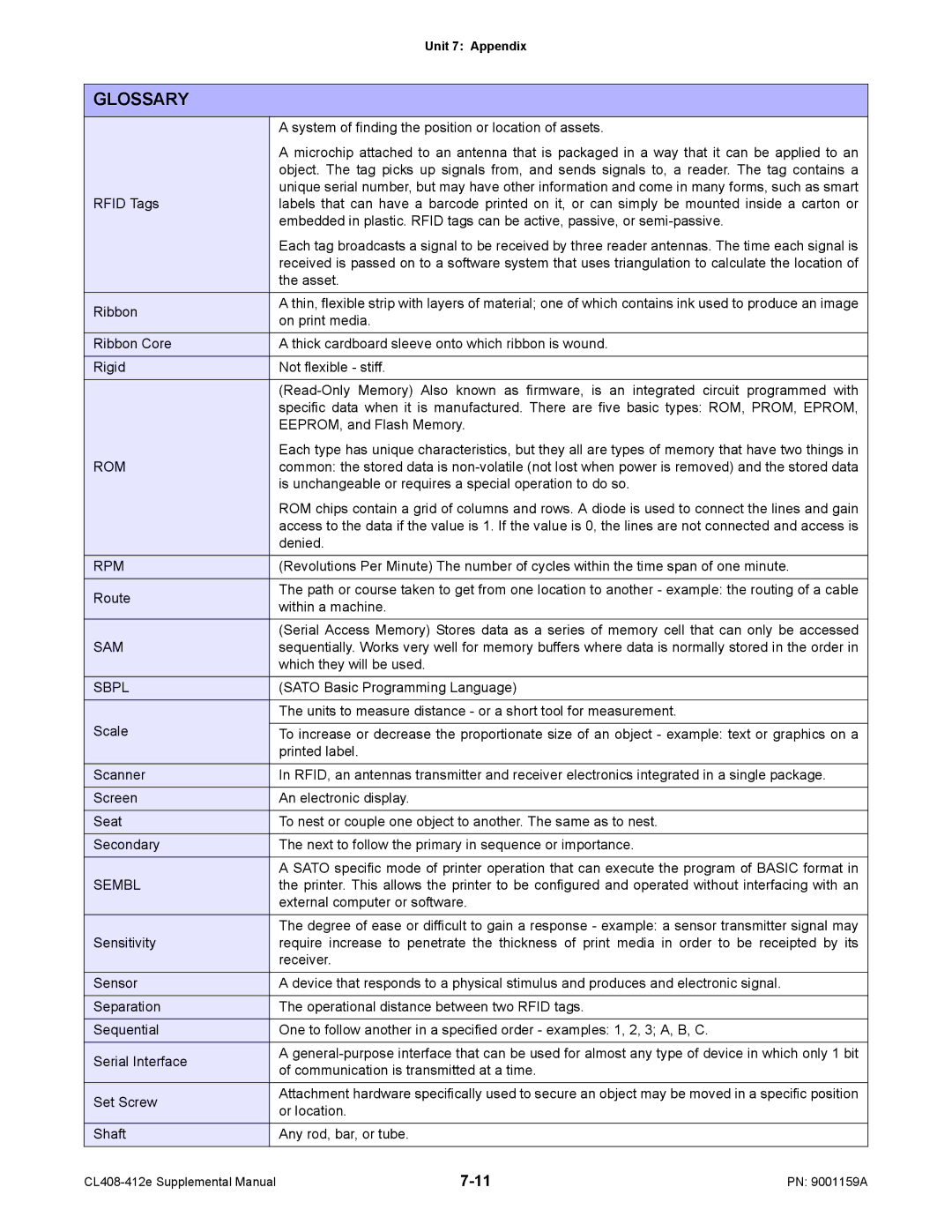
Unit 7: Appendix
GLOSSARY
| A system of finding the position or location of assets. | |
| A microchip attached to an antenna that is packaged in a way that it can be applied to an | |
| object. The tag picks up signals from, and sends signals to, a reader. The tag contains a | |
| unique serial number, but may have other information and come in many forms, such as smart | |
RFID Tags | labels that can have a barcode printed on it, or can simply be mounted inside a carton or | |
| embedded in plastic. RFID tags can be active, passive, or | |
| Each tag broadcasts a signal to be received by three reader antennas. The time each signal is | |
| received is passed on to a software system that uses triangulation to calculate the location of | |
| the asset. | |
Ribbon | A thin, flexible strip with layers of material; one of which contains ink used to produce an image | |
on print media. | ||
| ||
Ribbon Core | A thick cardboard sleeve onto which ribbon is wound. | |
Rigid | Not flexible - stiff. | |
| ||
| specific data when it is manufactured. There are five basic types: ROM, PROM, EPROM, | |
| EEPROM, and Flash Memory. | |
| Each type has unique characteristics, but they all are types of memory that have two things in | |
ROM | common: the stored data is | |
| is unchangeable or requires a special operation to do so. | |
| ROM chips contain a grid of columns and rows. A diode is used to connect the lines and gain | |
| access to the data if the value is 1. If the value is 0, the lines are not connected and access is | |
| denied. | |
RPM | (Revolutions Per Minute) The number of cycles within the time span of one minute. | |
Route | The path or course taken to get from one location to another - example: the routing of a cable | |
within a machine. | ||
| ||
| (Serial Access Memory) Stores data as a series of memory cell that can only be accessed | |
SAM | sequentially. Works very well for memory buffers where data is normally stored in the order in | |
| which they will be used. | |
SBPL | (SATO Basic Programming Language) | |
| The units to measure distance - or a short tool for measurement. | |
Scale |
| |
To increase or decrease the proportionate size of an object - example: text or graphics on a | ||
| printed label. | |
Scanner | In RFID, an antennas transmitter and receiver electronics integrated in a single package. | |
Screen | An electronic display. | |
Seat | To nest or couple one object to another. The same as to nest. | |
Secondary | The next to follow the primary in sequence or importance. | |
| A SATO specific mode of printer operation that can execute the program of BASIC format in | |
SEMBL | the printer. This allows the printer to be configured and operated without interfacing with an | |
| external computer or software. | |
| The degree of ease or difficult to gain a response - example: a sensor transmitter signal may | |
Sensitivity | require increase to penetrate the thickness of print media in order to be receipted by its | |
| receiver. | |
Sensor | A device that responds to a physical stimulus and produces and electronic signal. | |
Separation | The operational distance between two RFID tags. | |
Sequential | One to follow another in a specified order - examples: 1, 2, 3; A, B, C. | |
Serial Interface | A | |
of communication is transmitted at a time. | ||
| ||
Set Screw | Attachment hardware specifically used to secure an object may be moved in a specific position | |
or location. | ||
| ||
Shaft | Any rod, bar, or tube. | |
|
|
PN: 9001159A |
